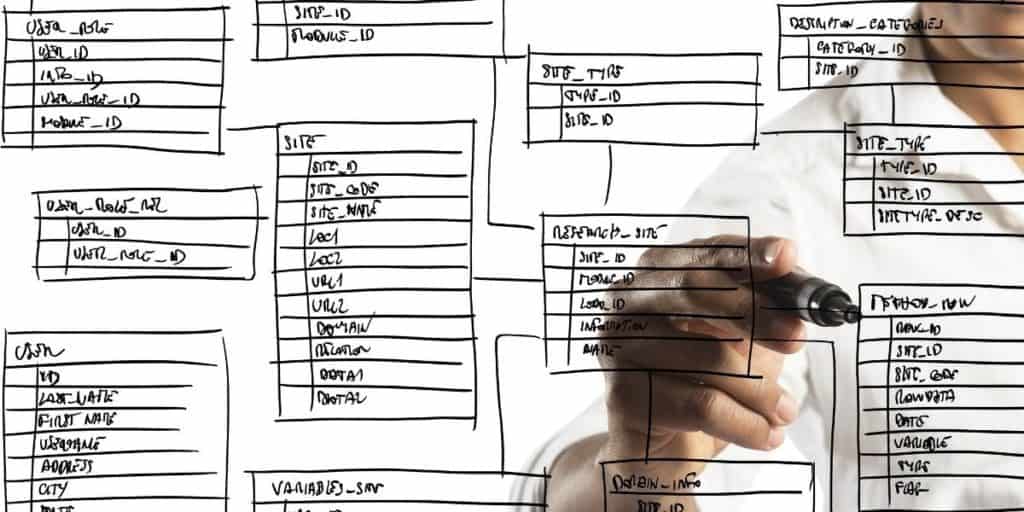SQL is a querying language that is very effective for use with relational databases. However, is it suitable for more expansive applications that involve big data?
You can use SQL effectively with big data—the complex datasets found outside of a relational database environment. However, this requires bridging the inefficiencies in latency that come with querying and processing vast amounts of data.
If you are interested in learning how SQL can be used in conjunction with big data, read on. We will cover how you can integrate SQL into machine learning, artificial intelligence, and other data-intensive operations.
Important Sidenote: We interviewed numerous data science professionals (data scientists, hiring managers, recruiters – you name it) and identified 6 proven steps to follow for becoming a data scientist. Read my article: ‘6 Proven Steps To Becoming a Data Scientist [Complete Guide] for in-depth findings and recommendations! – This is perhaps the most comprehensive article on the subject you will find on the internet!
Table of Contents
Can SQL Handle Big Data?
When looking at SQL and big data’s relationship, it is important to frame this relationship properly. It is not that SQL has compatibility issues with large data clusters. It is a matter of the more complex the architecture of the data warehousing, combined with the complexity of the query and the associated calculations, that can bring about latency and negatively impact the overall execution speed.

SQL is a declarative querying language. It is not a traditional programming language per se. It was developed specifically to interact by querying and manipulating existing data in tables. Imagine being an old-fashioned traffic officer directing traffic. In a mid-sized city with moderate traffic, it is not too difficult to maintain a steady traffic flow avoiding unnecessary congestion.
However, transpose that analogy to a much larger city filled with massive amounts of traffic across avenues and highways, each consisting of multiple lanes, and all of a sudden, no matter how efficient the traffic officer, you are going to have bottlenecks and congestion.
Such is the case with projects that require access to big data clusters for their queries and calculation. No matter how optimized the query, if it relies on accessing volumetric data across different databases and physical locations, it will get bogged down if these are relational databases.
The problem with big data and SQL is not the language itself. Instead, it involves executing those queries on a relational database architecture that is not designed for big data, resulting in inefficiencies.
It’s All About Relational Databases
As has been mentioned, SQL is the standard querying language for interacting with relational databases. It is quite efficient in that regard and has been standardized as such by multiple international standardization organizations.
Unfortunately, relational databases create response issues the larger and more complex they become. When you are talking about a data architecture that incorporates multiple data warehouses on-site, off-site, and the cloud, the structuring of queries and the computing resources required to process them can become too cumbersome.
In part, this is why non-relational platforms have been gaining in popularity for big data projects. Along with these platforms, languages specific to them have also appeared.
How Is SQL Good for Big Data?
If relational databases are not the most effective architecture for dealing with big data—and SQL is the default declarative language for these types of databases—how can SQL be good for big data? The answer to that question resides with the wide acceptance of SQL.
SQL Reduces Development Time
SQL is the de-facto standard language for interacting with relational database management systems. It has been the case for well over four decades. Database administrators, database architects, data analysts, data modelers are all familiar with SQL.
Such a deep level of adoption brings to SQL the firmness and soundness of a legacy language. In other words, SQL is a language that those who are working with data across different parts of the analytical model share in common. A lingua franca, if you will, for those working with the data.
It is easier for a new database architecture to be designed using a language that is as prevalent as SQL. It also makes it essential to incorporate interoperability in terms of the command and syntax structure between SQL and non-relational database platforms.
Even if you worked entirely on a non-relational database built with horizontal scalability, SQL knowledge would still be a great benefit. You can query many of these platforms with the SQL language through the use of extensions. Others without those extensions rely on querying protocols that mimic or are very similar to recognized SQL syntax.
The Synergistic Dichotomy Between SQL and NoSQL
You would think that relational and non-relational databases being fundamentally different from one another, would each function on their own, bringing about their own set of advantages to those using them. However, when dealing with big data, you can only obtain certain benefits through a synergetic existence between SQL and NoSQL.
When it comes to storing the massive amounts of data required for many data operations, there is a benefit from the horizontal scaling offered by non-relational databases. However, if the data you are working with is highly structured, SQL holds a distinct advantage.
So, how can you exact the benefit of the SQL and NoSQL universes?
Querying JSON With SQL
JSON is a textual data format commonly used in the storage of unstructured data in non-relational databases.
Dialects of SQL, such as MySQL from version 5.7 forward, incorporate features that will allow you to store, query, and manipulate data in JSON. This data can also be indexed. NoSQL data indexing is accomplished by how these MySQL features generate columns as needed to perform the indexing.
The importance of this is that it is possible to manipulate data initially structured for a NoSQL environment under an SQL environment. Likewise, it can take data structured for a relational database structure and make it NoSQL-friendly.
Distributed SQL Query Engines
Another way to derive efficient use of big data with SQL is to use a distributed SQL query engine. Unlike an SQL server storage engine that reads, creates, and updates data between a database server’s disk storage and memory, a distributed SQL query engine is software-based. It allows you to query data from a variety of sources.

You can use the data from these multiple sources for an individual query. It can also be used as part of a series of queries. It also allows for multiple queries to be run simultaneously on different parts of the computer cluster.
In doing so, one of the biggest drawbacks of SQL databases is curbed. Speed and response issues are lowered by spreading the processing power required for complex queries and calculations closer to where the different data components are stored.
Distributed SQL query engines do not allow for the direct manipulation of NoSQL-formatted data as the JSON method mentioned above. Still, they do make it possible to run complex calculations on a SQL relational database with a level of efficiency not obtainable without it.
This type of engine opens up the feasibility of using relational databases for operations heavily reliant on big data. These include machine learning, predictive analytics, and other intensive operations. It also allows for the incorporation of cloud-based infrastructure, thereby adding scalable processing power and storage capacity as needed.
Author’s Recommendations: Top Data Science Resources To Consider
Before concluding this article, I wanted to share few top data science resources that I have personally vetted for you. I am confident that you can greatly benefit in your data science journey by considering one or more of these resources.
- DataCamp: If you are a beginner focused towards building the foundational skills in data science, there is no better platform than DataCamp. Under one membership umbrella, DataCamp gives you access to 335+ data science courses. There is absolutely no other platform that comes anywhere close to this. Hence, if building foundational data science skills is your goal: Click Here to Sign Up For DataCamp Today!
- IBM Data Science Professional Certificate: If you are looking for a data science credential that has strong industry recognition but does not involve too heavy of an effort: Click Here To Enroll Into The IBM Data Science Professional Certificate Program Today! (To learn more: Check out my full review of this certificate program here)
- MITx MicroMasters Program in Data Science: If you are at a more advanced stage in your data science journey and looking to take your skills to the next level, there is no Non-Degree program better than MIT MicroMasters. Click Here To Enroll Into The MIT MicroMasters Program Today! (To learn more: Check out my full review of the MIT MicroMasters program here)
- Roadmap To Becoming a Data Scientist: If you have decided to become a data science professional but not fully sure how to get started: read my article – 6 Proven Ways To Becoming a Data Scientist. In this article, I share my findings from interviewing 100+ data science professionals at top companies (including – Google, Meta, Amazon, etc.) and give you a full roadmap to becoming a data scientist.
Conclusion
When it was first developed, SQL was intended to serve as a querying language for relational databases. In the nearly five decades of its existence, it has excelled at that task and has become the industry standard.
The inherent inefficiencies associated with big data and relational databases have not diminished the role of SQL with big data. The popularity of SQL makes it a universal language for all those involved with data. In turn, SQL, through distributed query engines and JSON manipulation, provides an excellent way to work with big data.
BEFORE YOU GO: Don’t forget to check out my latest article – 6 Proven Steps To Becoming a Data Scientist [Complete Guide]. We interviewed numerous data science professionals (data scientists, hiring managers, recruiters – you name it) and created this comprehensive guide to help you land that perfect data science job.
Affiliate Disclosure: We participate in several affiliate programs and may be compensated if you make a purchase using our referral link, at no additional cost to you. You can, however, trust the integrity of our recommendation. Affiliate programs exist even for products that we are not recommending. We only choose to recommend you the products that we actually believe in.
Recent Posts
Data science has been a buzzword in recent years, and with the rapid advancements in artificial intelligence (AI) technologies, many wonder if data science as a field will be replaced by AI. As you...
In the world of technology, there's always something new and exciting grabbing our attention. Data science and analytics, in particular, have exploded onto the scene, with many professionals flocking...
